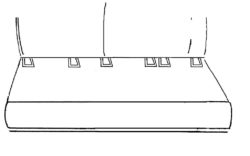UPDATE: The Lifesavers Conference session mentioned in the following article is now offered as a recorded Safe Kids-hosted webinar.
How to Tell if a Car Seat is Legit—or NOT
Watch it here.
One of the many excellent sessions planned for the Lifesavers Conference (March 15–17 in Tampa, Florida) focuses on noncompliant CRs, a very timely topic. Attendees will hear from a CR manufacturer and a CPST-I who has reported non-compliant CRs seen in the field. In addition, a representative of NHTSA will explain various regulatory considerations of these products.
As a member of the Lifesavers planning committee, SRN’s Denise Donaldson has been gathering examples, both online and in person, of the growing number of noncompliant products seen in this country. Readers who encounter unusual products are urged to share this information by emailing a detailed description and photos to info@saferidenews.com.
Manufacturers must self-certify CRs, and most products are designed and sold by trustworthy, legitimate companies. However, the public must be vigilant about noncompliant devices, especially ones presented for sale online by vendors who may feel safely concealed from accountability. Sadly, the online marketplace has certainly made it easier for unscrupulous vendors to sell products in the U.S. and Canada that don’t meet applicable regulations.
As this topic has been hot lately, including in mainstream media, many terms have been used to describe problematic devices. SRN deems it time, therefore, to consider terminology a little more closely.
Legitimate CRs Are FMVSS 213-Compliant
First, it’s important to know what it means for a CR to be “213-compliant”—a legitimate CR. A compliant product meets all the performance, structural integrity, and labeling standards of NHTSA’s Federal Motor Vehicle Safety Standard 213, and it fits the definition of one of the CR types to which the standard applies. Therefore, it must be a product for a child who weighs less than 80 pounds and be a rear-facing CR, forward-facing CR, belt-positioning booster seat, car bed, or harness system. The CR may be an add-on or built-in, and the regulation applies to CRs used in any motor vehicle (including school buses) or aircraft. In state child occupant protection (COP) laws, the use of only FMVSS 213-compliant CRs is specified. (Note for Canadian readers: Although this article is U.S.-centric, much of the content applies to Canada; replace U.S. terms (like FMVSS 213) with their Canadian counterparts.
Whenever possible, refer to any noncompliant product that poses as or competes with compliant CRs a “device,” rather than a child restraint. That way, the term “child restraint” is reserved for legitimate products that truly meet standards. But, among these non-CR devices, there are different types. SRN suggests CPSTs consider the following categories:
Fakes/Frauds
Knockoffs: Devices that are inferior copies of particular 213-compliant CR models. In recent months, SRN has heard about knock-offs of the Doona CR and certain Graco RF-only CRs. The makers of these devices rip off the companies they imitate; even worse, the knockoffs are made of substandard materials that lack the strength and integrity of the real thing, do not meet standards, and are a huge risk to children. Warn caregivers to avoid deals that are too good to be true!
Counterfeits: Devices that appear to be 213-compliant CRs, but do not imitate any particular CR model Like knockoffs, these devices may make claims that they meet federal regulations. However, they typically have clues to the contrary, such as cheaper-looking parts or missing labels. (Recent examples have been sold online as part of a stroller system.)
Imposters: These devices identify themselves as CRs using the language required by FMVSS 213 (in marketing materials, instructions, and labels). However, they do not meet FMVSS 213’s definition of a CR, so this claim is fraudulent. In addition, imposters often say they meet FMVSS 213 crash standards, but since they don’t qualify as a CR under that standard, these claims are baseless. Some seat belt adjusters are examples of imposters, as are devices with a five-point harness that are installed by wrapping a strap around the vehicle seatback (always a clear no-no in personal vehicles).
Other Confusing Products
Decoys: These devices are like imposters, but the manufacturer steers clear of making fraudulent claims of meeting FMVSS 213. Nonetheless, promotion of such a product often willfully misleads the public into thinking that it is a legitimate alternative to a CR. For instance, many decoys state a starting weight limit of 80 pounds so as to fall outside the scope of FMVSS 213, yet their packaging and promotional materials show the device in use by much smaller/younger children. Since no rules or laws have been broken, the most that can be done is to educate the public about avoiding these products.
Foreign CRs: These are legitimate CRs that are designed to meet the standards of a foreign country, but not FMVSS 213. People visiting from abroad may use their foreign-made models for short stays (like while on vacation). However, people who plan to live in the U.S. for an extended period of time (for instance, on a work visa) should obtain a 213-compliant model. U.S. citizens should not purchase a foreign model for use in the U.S., and NHTSA should be notified if manufacturers or retailers are found to be offering to ship models that don’t meet U.S. regulations to U.S. addresses.
Stay Up to Date!
The current CR market is especially tricky, with online retailers able to pop up at will (and resurrect themselves elsewhere if called into question). At the same time, several unusual CR features and designs—many inspired by foreign CRs—are now found in legitimate CRs in the U.S. market. Additionally, the demand for lightweight, portable options has led to the invention of products that manufacturers have carefully tested for safety but that do not strictly meet the FMVSS 213 definition of a CR (for instance, harness-like products that do not utilize a tether or boosters that do not boost). Are these “better mousetraps” by designers who have been thinking outside the box or simply imposters? These are questions regulators may need to address in the coming months.
Readers of SRN can count on coverage of new products—legitimate or otherwise—in this newsletter. Another way to check on a product and/or a CR manufacturer is to see if it’s included on the AAP’s annual product listing of CRs. (Remember, however, that this list is updated annually; while finding a model listed here is a good sign that it is legit, the absence of a model may simply mean it is new to the market, so further research would be necessary.)
In general, CPSTs with concerns about any product are encouraged to follow up. Contact the manufacturer and ask questions. Report lingering concerns to the manufacturer and to NHTSA (click on Report a Problem).
And don’t forget to share with SRN, as well. Hope to see you at the Lifesavers Conference in March!



